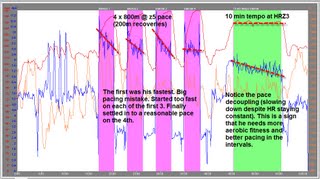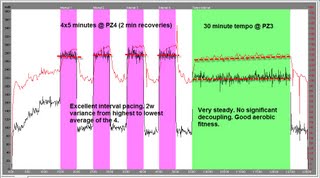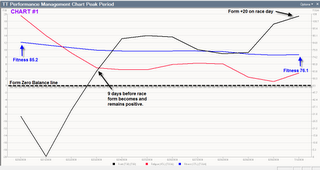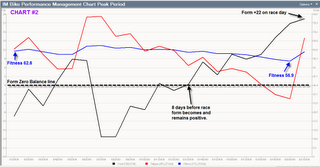Two-a-Days
This post was the suggestion of a reader. If there is a topic you'd like to see discussed here please write to me. I'm always open to your ideas.
It’s common among advanced multisport athletes to do two workouts in a day. Some even do three-a-days. The demands of such a sport make multiple daily sessions a necessity for high-performance. Some of these two-a-day triathlon workouts may be “bricks,” workouts combining two or more sports such as bike-run, swim-bike or swim-bike-run sessions. In triathlon such workouts are done year round.
There are also some mono-sport athletes, such as runners and cyclists, who do two-a-days. But these are not nearly as common as in multisport. Should you as a cyclist, runner, or swimmer do two (or more) sessions in a single day? There is no easy answer for this question. There are only possible advantages and disadvantages. Here are some of them.
Advantages
The way you increase fitness is to gradually increase stress. Stress comes in the guise of workout duration, intensity and frequency. Increasing any of these while maintaining the others improves fitness. Duration and frequency taken together are called “volume” – how many hours or miles you do in a week. By doing two workouts in a day you have the opportunity to increase volume and thus fitness.
Double workouts also increase the possibility of greater intensity of training. And intensity is the key to success for high-performance athletes. How does intensity increase? Let’s take an example. You could do a single, two-hour workout in one day including intervals followed by a long, steady effort. This would produce a lot of fatigue and you would likely not produce your best-possible performance for either portion of the workout as a result. But if you divided this into two sessions, one in the morning and one in the afternoon, fatigue (and your perception of expected fatigue which may cause you to hold back somewhat) would be lessened and so performance could rise. The first session might be the intervals and the second the steady-state effort. By the afternoon workout your greater recovery could produce a higher power or pace output. So, more stress from increased intensity would mean more fitness even if volume didn’t increase.
Two-a-days also increase your fat burning helping to reduce excess body weight. Following a workout, especially an intense one, your body continues to burn fat during recovery. The harder the workout, the longer this fat burning continues. By doing two workouts in a day you get this fat-burning benefit twice. It may not last any longer in total for the day than had you done only one long session, but causing it to occur twice in a day may have some fat-burning benefits although I’ve not seen any research to support this. This is based strictly on experience.
Disadvantages
Of course, as with everything in life, there are disadvantages to working out twice in a single day. And they are potentially more deleterious than the benefits.
Increased stress means increased fatigue. Some athletes seem to handle that very nicely and bounce back quickly. Others, especially novices and seniors, recover more slowly. So several double days could easily lower the quality of your training.
And more stress also raises the specter of overtraining from trying to do too much in too short a period of time. Raising the workload significantly by doing two-a-days could cause an athlete to become overtrained in just three to six weeks depending on how well he or she copes with stress.
For many runners the risk of injury rises quite quickly as the frequency of training increases. I have coached many runners over the years who have what I call “glass legs.” It doesn’t take much stress to damage them which could leave such an athlete hobbled for days if not weeks. So for the runner, two-a-day workouts are very risky. What some do to avoid this problem while reaping some of the double-daily benefits, especially the fat burning, is to ride a bike as the second session of the day. There is even some research showing that riding a bike improves running performance.
While cycling isn’t an impact sport like running, increased risk of injury can still come with riding twice a day. For the cyclist the knees are typically where overuse injury is mostly likely to occur. This may be related to mediocre pedaling skills, unusual biomechanics, too much climbing in too high of a gear, or, most commonly, a poor bike setup.
Guidelines
So if you’re a mono-sport athlete and decide to start doing two-a-days, how should you train to minimize the downsides while reaping the benefits? Here are some basic guidelines.
+ Only do twice-daily workouts if you are an advanced athlete, meaning, primarily, that you have been at the sport for two or three years.
+ For runners and cyclists the best time to start doing two-a-days is in the base period. Keep the intensity low with the focus only on volume at first.
+ Allow your body to adapt gradually over several weeks. Start by doing only one day in a week with two workouts. If your body handles that alright then eventually bump it up to two. Do a couple of weeks like this before going to two double days. I’d recommend doing no more than three such double-dailies a week in your first season of trying this. Keep the risk low as you learn how your body responds.
+ At first use your easiest training days for two workouts. If you handle that alright then begin to carefully experiment with a more intense session followed by an easy session the same day.
+ Provide adequate time for recovery between the two daily sessions. There should be at least one meal in the recovery period. Two are better. This could be a workout before breakfast and a second session before supper with a lunch in between.
+ Allow for variety in these workouts. Don’t always do the same sessions each time you do two-a-days.





